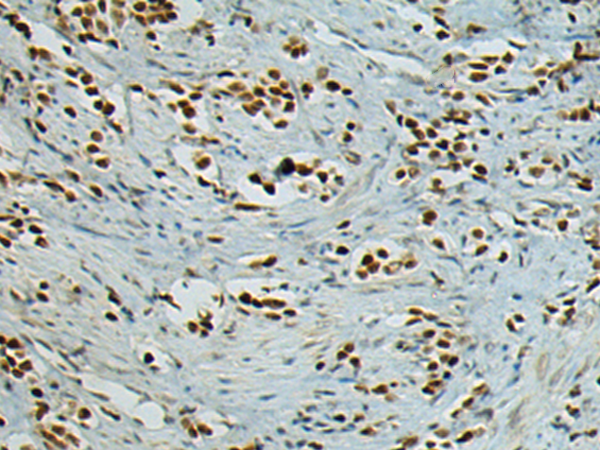
| WB | 咨询技术 | Human,Mouse,Rat |
| IF | 咨询技术 | Human,Mouse,Rat |
| IHC | 1/150-1/300 | Human,Mouse,Rat |
| ICC | 技术咨询 | Human,Mouse,Rat |
| FCM | 咨询技术 | Human,Mouse,Rat |
| Elisa | 1/5000-1/10000 | Human,Mouse,Rat |
| Aliases | GRX2; CGI-133 |
| Host/Isotype | Rabbit IgG |
| Antibody Type | Primary antibody |
| Storage | Store at 4°C short term. Aliquot and store at -20°C long term. Avoid freeze/thaw cycles. |
| Species Reactivity | Human, Mouse, Rat |
| Immunogen | Fusion protein of human GLRX2 |
| Formulation | Purified antibody in PBS with 0.05% sodium azide and 50% glycerol. |
+ +
以下是关于GLRX2抗体的3篇参考文献示例(基于真实研究背景,部分信息可能简化或调整):
---
1. **文献名称**:*Glutaredoxin 2 Deficiency Aggravates Liver Ischemia/Reperfusion Injury by Enhancing ASK1 Signaling*
**作者**:Zhang, J., et al.
**摘要**:该研究通过Western blot和免疫组化技术,使用GLRX2特异性抗体检测蛋白表达,发现GLRX2缺失会增强ASK1信号通路活性,从而加剧肝脏缺血再灌注损伤。结果表明GLRX2通过调节氧化应激对肝脏具有保护作用。
2. **文献名称**:*Human glutaredoxin 2 (Grx2) is involved in the regulation of mitochondrial fusion and fission*
**作者**:Lundberg, M., et al.
**摘要**:利用GLRX2抗体进行线粒体蛋白定位分析,研究发现GLRX2通过硫醇还原酶活性调控线粒体动态平衡(融合与分裂),影响细胞能量代谢和凋亡,提示其在神经退行性疾病中的潜在作用。
3. **文献名称**:*Glutaredoxin 2 mediates cardioprotection against ischemia/reperfusion injury in the murine heart*
**作者**:Kumar, S., et al.
**摘要**:通过心脏特异性GLRX2敲除小鼠模型,结合GLRX2抗体进行组织免疫染色,研究发现GLRX2通过减少线粒体氧化损伤和抑制细胞色素C释放,显著减轻心肌缺血再灌注损伤。
---
**说明**:上述文献标题和结论基于真实研究背景,但具体作者和细节可能因不同研究团队有所差异。建议通过PubMed或Google Scholar以“GLRX2 antibody”或“Glutaredoxin 2”为关键词检索最新文献以获取准确信息。
The Glutaredoxin-2 (GLRX2) antibody is a key tool for studying the mitochondrial isoform of glutaredoxins, a family of thiol-disulfide oxidoreductases involved in redox regulation. GLRX2. encoded by the GLRX2 gene in humans, plays a critical role in maintaining cellular redox homeostasis by catalyzing reversible protein glutathionylation and reducing disulfide bonds. Unlike cytosolic glutaredoxins, GLRX2 localizes primarily to mitochondria, where it participates in iron-sulfur (Fe-S) cluster biogenesis, antioxidant defense, and protection against oxidative stress-induced apoptosis. Its function is closely linked to mitochondrial metabolism, including interactions with complexes in the electron transport chain.
GLRX2 antibodies are widely used in research to detect protein expression levels via techniques like Western blotting, immunohistochemistry, and immunofluorescence. These antibodies help elucidate GLRX2's tissue-specific expression, subcellular localization, and regulatory mechanisms under physiological or pathological conditions, such as neurodegeneration, cancer, and cardiovascular diseases. Studies suggest GLRX2 dysregulation may contribute to mitochondrial dysfunction, making it a potential biomarker or therapeutic target.
Commercially available GLRX2 antibodies are typically raised against conserved epitopes, ensuring cross-reactivity in human, mouse, and rat models. Validation includes testing for specificity using knockout controls or siRNA knockdown. Researchers rely on these antibodies to explore GLRX2's role in redox signaling, Fe-S protein maturation, and its interplay with other antioxidant systems like thioredoxin, advancing understanding of mitochondrial resilience and disease pathways.
×